

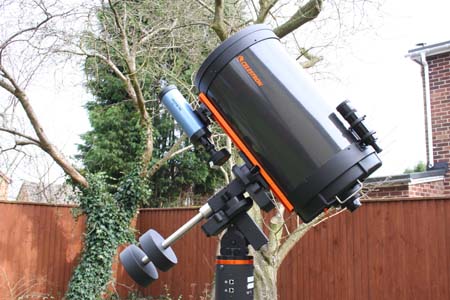
My first attempts were to attach the guide scope to the top of the C14 tube, however, you can not balance the mount with the counter weights supplied. Although in principle I could get an extra counter weight, the advice so far is that I should avoid doing this. As a note, I bought a camera mount for the C14 that attaches to the top of the tube, however, I have not been able to use it with my camera because I can not balance the scope with it attached. At some point I can see that I might have to get another small counter weight.
The camera shown on the Skywatcher is an Orion SSDSI camera, again, this has worked well for me in the past for guiding on the Classic.
Update: I now also have a 11lb weight which I use with the spectroscopy set up (see other pages). So far this additional weight seems to be OK.
With everything set up and a clear night predicted it was time to try guiding the CGE1400 for the first time. The Polar alignment was good as it turned out and only minor adjustments were required with the drift method. I suspect that no adjustment would have been necessary if the front leg of the tripod had not lowered slightly under the weight of the telescope, I am not sure if the leg slipped a little or if the paving slab settled under the weight, but it is something to watch in the future. If it is the leg slipping then it will need some sort of fix, I would not want the telescope to tip over!
With the telescope aligned a test was done to see what sort of drift occurred over 3minutes, shown on the right.
This was rather pleasing, I never had anything as good as this with the Classic.
In the past I have used Astroart 4.0 to guide the LX200 and it worked very well, however, I spent several hours trying to get it to guide the CGE without any success. I really do not know why this is, but I tried everything that I could think of, but it just made the images worse than without any tracking, which rather defeats the object! I plan to figure out why this would not work some time because it does not seem to make any sense to me.
My first attempt at guiding at f11 on the CGE with the Orion SSDSI is shown on the right. There was a fairly strong wind and one of the frames that I used was poor, which is why the stars are not quite round.
No flats were taken and there is amplifier glow in the bottom right which I have not removed, but if you compare this to the picture that I took with the Classic ( Classic M95 picture ) you can see the difference. Smaller field of view but more detail, look particularly at the clump of stars just below M95 at about 7 O'clock (they are about 11 O'clock on the classic photo).
At this point I had to pack up for the night due to cloud. I am looking forward to next time now......
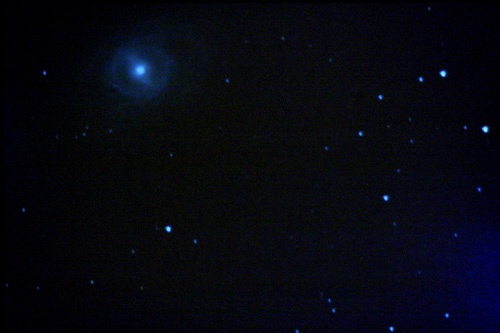
Last night there was a thin layer of cloud which made it poor for imagining, however, Arcturus was clear enough to sort out guiding with the MaxIm DL software. Although PhD guide is working well, there is more functionality in MaxIm and I also felt that if I put some time into this I might be able to guide better with this software in the long run.
I set up the guide camera with the x axis lined up with the RA axis of the telescope and used the graph function within MaxIm to monitor what was happening. Things improved dramatically by increasing the calibration time to 20s in X and 30s in Y. The next improvement was to set the backlash in Y to 1s. The telescope was then tracking approximately +/- 2 pixels. Reducing the aggressiveness factors to X = 5 and Y=6 made the tracking as good as I think it will get, the error was really very small, much better than +/- 1 pixel on the graph, even though it was fairly windy.
Now I need to wait for a clear sky to see how it works in practice!
The telescope was set up and polar aligned, but I did not use the drift method to refine the polar alignment tonight. My aim was to test out the tracking and PHD guide software. A 3 minute exposure with no guiding looked OK, a bit extended but not too bad. I then set the PHD guiding up on a reasonably bright star and set 15 x 3min exposures at ISO800 going. I then stacked them without aligning each frame to get the picture shown to the right.
Each star here is actually 4 dots, the number of frames for each dot is 4, so the period for each dot is 12 minutes, a quick check of the raw images shows that this is the case, each consecutive 4 frames stack fine, then there is a jump.
Looking at this against a star map, the jumps seem to be in DEC, not sure why they have a period of 12 minutes. Perhaps it is to do with the guiding software, clearly requires further investigation. I hope that with a precise polar alignment this effect will be removed. Altering the backlash settings in DEC might also help a little, it is not very responsive visually with the hand set in DEC at the moment and does tend to jump suddenly when you try to make alterations.
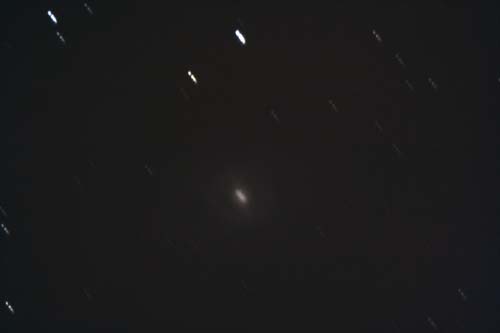
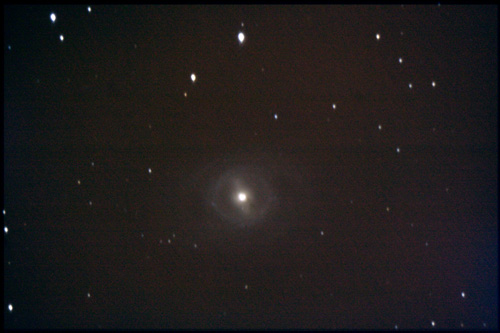
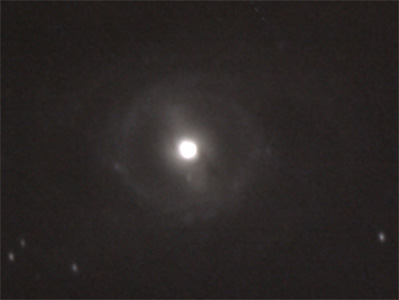

Test Exposures
I have now run a series of test exposures with MaxIm DL set up as described above. Shown to the right is a star from a 300s single exposure on the main camera, which was obtained at f11, and 5s exposures on the guide camera. The shorter the exposures on the guide camera, the better the result. At f11, 10s exposures on the guide camera allow 180s exposures on the main camera and still get a good star shape. The issue is finding bright enough guide stars to allow very short guide camera exposures and more accurate guiding. I plan to try the Wantec out as a guide camera, I think this is likely to be more sensitive. For spectroscopy the level of accuracy with 10s guide exposures for 300s imaging frames is fine, it does not matter if the star moves slightly of the spectroscope slit and then back again.
The small errors that I am getting are still in DEC, the tracking in RA as very good. I have not checked the alignment of the telescope for a while and this could be refined I am sure, and would probably reduce what DEC error there is.
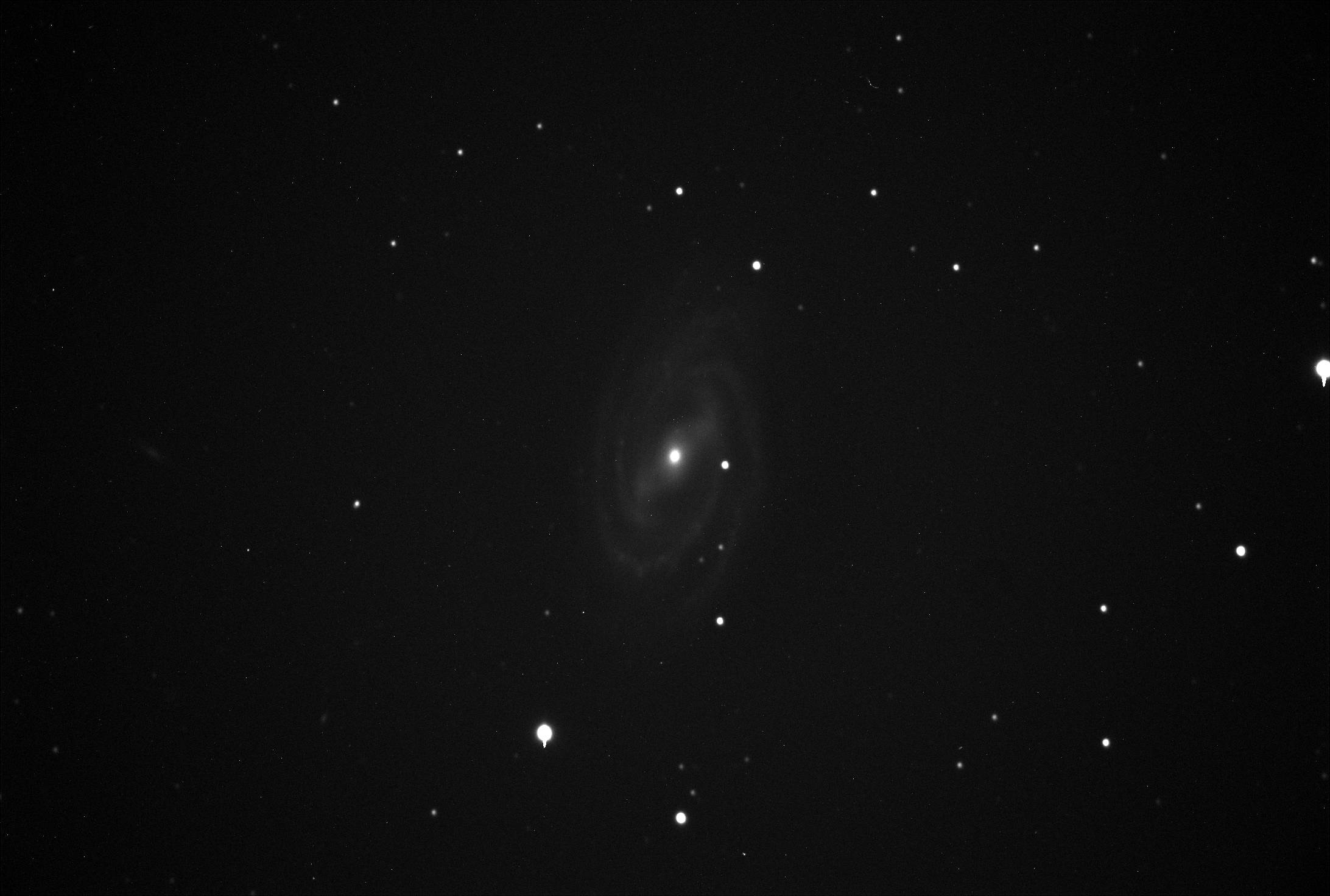
To the left is a star taken at f6.55 with an exposure time of 5 minutes. The polar alignment was done in a fraction of the time that it usually takes me to get tracking this good.
Below this is the full frame exposure that this star was taken from. 300s exposure at F6.55 of M109. CGE1400. PhD guide used with 4s exposures on guide camera

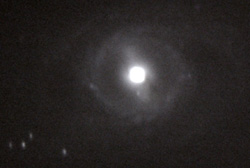
This is another image of M95, I rather like this as a test object (if you had not already guessed that!). The image is 15 x 183s, at ISO 800 and f11. The stars are not round yet, but more detail is coming out.
Time to pack up again, storms with high winds are on the way...also there is now a thin layer of cloud which is making it hard to get a guide star.